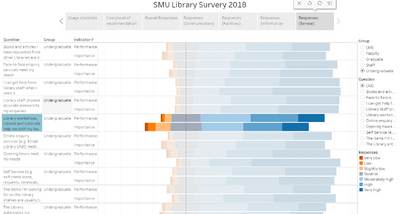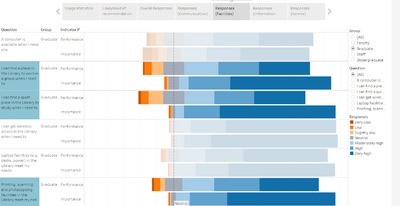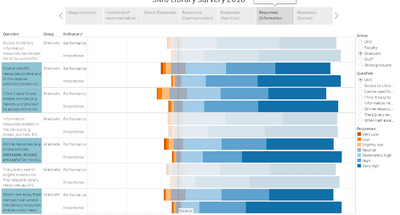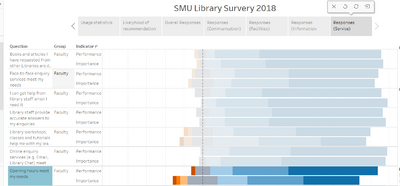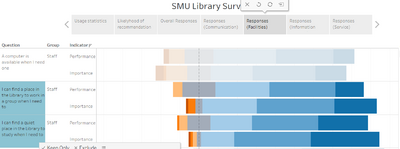Difference between revisions of "IS428 AY2019-20T2 Assign CHUA MING YU"
| (5 intermediate revisions by the same user not shown) | |||
| Line 128: | Line 128: | ||
|Lastly, for the service category, the performance of the library is also similar to the importance. The question that stands out the most is the question on the workshops that the library holds. It seems that undergraduates view the library workshops as less important then its actual performance. Even though in this case the library is performing better than expected, as an institution of higher learning, the library should still be concerned that the undergraduates do not find the library workshops important. | |Lastly, for the service category, the performance of the library is also similar to the importance. The question that stands out the most is the question on the workshops that the library holds. It seems that undergraduates view the library workshops as less important then its actual performance. Even though in this case the library is performing better than expected, as an institution of higher learning, the library should still be concerned that the undergraduates do not find the library workshops important. | ||
| − | |||
| − | |||
| − | |||
| − | |||
| − | |||
| − | |||
| − | |||
| − | |||
| Line 196: | Line 188: | ||
The items that the graduate students are looking for on the shelves are also usually not there. This might be due to other students browsing the books and not placing them back. The library could do better to educate its users to place back the books after browsing. | The items that the graduate students are looking for on the shelves are also usually not there. This might be due to other students browsing the books and not placing them back. The library could do better to educate its users to place back the books after browsing. | ||
| − | |||
| − | |||
| − | |||
| − | |||
| − | |||
| − | |||
| − | |||
| − | |||
| − | |||
| − | |||
| − | |||
| − | |||
| − | |||
| − | |||
| − | |||
| − | |||
| − | |||
| − | |||
| − | |||
| − | |||
| − | |||
|} | |} | ||
| Line 324: | Line 295: | ||
|} | |} | ||
| + | |||
| + | =Conclusion= | ||
| + | Overall for each of the groups, SMU library has performed well in terms of communication and service. In these two categories, the performance and the importance in the responses have not much differences. | ||
| + | |||
| + | However more needs to be done for facilities and information resources. Below are a few of the key points faced by all groups of users to work on. | ||
| + | [[File:Place group work.png|400px|thumb|none]] | ||
| + | All 4 groups of users mention that the performance of SMU library when it comes to securing a place for group work falls far from the importance they place for it. | ||
| + | [[File:Quiet.png|400px|thumb|none]] | ||
| + | Many users also cannot find a quiet place to work in the library. | ||
| + | [[File:Mobile.png|400px|thumb|none]] | ||
| + | More could be done to make online resources mobile friendly and accessible. | ||
| + | |||
| + | =Resources= | ||
| + | |||
| + | The resources I utilized are as such. | ||
| + | |||
| + | https://kb.tableau.com/articles/howto/creating-a-calculation-that-ignores-filters | ||
| + | <br> | ||
| + | https://www.youtube.com/watch?v=JodWmiIxl2c | ||
| + | <br> | ||
| + | https://www.clearlyandsimply.com/clearly_and_simply/2011/11/dynamic-sorting-with-tableau.html | ||
| + | <br> | ||
| + | https://www.tableau.com/sites/default/files/media/whitepaper_surveydata_v4.pdf | ||
| + | <br> | ||
Latest revision as of 23:53, 15 March 2020
IS428 Visual Analytics for Business Intelligence
Contents
Overview
Every two years, SMU Libraries conduct a comprehensive survey in which faculty, students and staff have the opportunity to rate various aspects of SMU library's services. The survey provides SMU libraries with input to help enhance existing services and to anticipate emerging needs of SMU faculty, students and staff.
The interactive tableau chart can be found at here [1]
Data Preperation
Tableau Prep was used to process the data given in "Raw data 2018-03-07 SMU LCS data file - KLG.xlsx"
The overall steps look like:
Since the objective was to get the level of service as perceived by 4 main groups, when I processed the responses, I did not discriminate between the most frequented library, school that person is in, and the finer details of the groupings(eg. year 1, year 2).
Below will be a step by step guide of what I did to get the final output.
| Screenshot | Steps |
|---|---|
| I added both sheets into tableau prep | |
| I removed all the responses where respondents responded that it is not applicable to them | |
| I pivoted the values so that instead of having multiple responses to multiple questions in one row, each row will represent one response to one question | |
| I renamed several columns so that the headers have more meaning. Then I pivoted it so that there will be one row per question and answer. | |
|
|
I filtered out all the null values that appear due to the previous pivot step. |
| I did an inner join on both sheets so that I can get all the responses and their corresponding meaning | |
| I used a whole bunch of merge statements to replace the responses for Position, StudyArea, ID, Campus. This allows for the values to have meaning instead of staying as numbered responses. |
Graphs and insights
Undergraduates
| Number | Screenshot | Insights |
|---|---|---|
| 1 | Almost all undergraduates who responded have visited the library before, whereas there are a few undergraduates who have not utilized the library resources before. There may be an underlying issue here about how undergraduates do not know how to access the library services, and that more could be done to educate undergraduates on how to access library resources. | |
| 2 | Undergraduates here are likely to recommend the library to others. Even though their scoring is lowest among all 4 groups, however it is still positive. | |
| 3 | It seems that there is a huge difference in the perceived importance of the facilities in the library, and its actual performance. Among all the undergraduates who rate the facilities as important, there is a gap of 29.2% in the number of users who rate the actual performance of the library as high. | |
| 4 | Examining the issue further by looking into the individual questions for the category, facilities, we notice a few questions that are instrumental in causing the gap in performance and importance. They are the issues of users being unable to find places in the library to conduct group work, the library is too noisy, and the the printing services do not meet the needs of the users.
Since the survey was done in 2018, with the recent opening of SMU connexion, we might see improvements in the amount of spaces available for undergraduates to conduct group work. Last year in 2019, SMU was on a journey to improve the printing services. This action could have been spurred by the results of the survey. As for whether it helped to improve printing services, we have to examine the survey results of future years. As for the noise levels in the library, more could be done by the library to get users to keep their volume as low as possible. | |
| 5 | Another area where there is a noticible different between performance and importance is in the informantion resources category. | |
| 6 | Looking into the individual questions for information resource, we notice that the greatest discrepancy comes from the question of whether users find it easy to use mobile devices to access online resources. What we can take away is that the infrastructure of the school does not allow for users to be able to easily gain access to the information while on mobile devices. Personally I feel that this is a very salient point as undergraduates need to fully utilize their time to study, even while travelling on public transport. Have mobile friendly access to resources will allow for users to be able to study as and when they want to, even if they are travelling from home to school | |
| 7 | As for the communication category, the performance of the library is similar to the importance that the respondents replied. Nitpicking the results, we can say that a large amount of users are neutral about the library services available. This could be a sign that although the undergraduates know about library services available, they are unsure if the scope of their knowledge is the whole scope of service that the library can provide. Perhaps more informative brochures or posters can be prepared that lists out all library servies for undergraduates to explore. This ties in with the previous points where I mentioned that some users have not accessed any of the resources that the library is able to provide. | |
| 8 | Lastly, for the service category, the performance of the library is also similar to the importance. The question that stands out the most is the question on the workshops that the library holds. It seems that undergraduates view the library workshops as less important then its actual performance. Even though in this case the library is performing better than expected, as an institution of higher learning, the library should still be concerned that the undergraduates do not find the library workshops important.
|
Graduates
| Number | Screenshot | Insights |
|---|---|---|
| 1 | Similar to the undergraduates, there are almost no undergraduates who have not been to the library before. However, similarly, there is a small amount of graduate students who have not accessed the library resources. | |
| 2 | Graduate students are very happy with SMU library. At 46.9% scoring for net promoter score (calculated by % of promoters - % of detractors), graduate students have a high propensity to recommend SMU library to others. | |
| 3 | For graduate students, there appears to be a big gap between the importance they place on the facilities of the library, and its actual performance.
| |
| 4 | Examining the individual questions for facilities, there are 3 main questions that cause the discrepancy. The issues are users being unable to find places in the library to conduct group work, the library is too noisy, and the the printing services do not meet the needs of the users. These issues are the exact same issues faced by the undergraduates, and goes to show that graduate students and undergraduate students have similar concerns when it comes to use of the library. | |
| 5 | When examining the responses to questions under the category of information resources, there are 4 areas there the discrepancy is noticible. They are the issues of course resources being good enough, mobile friendliness of resources, usefulness of library resources, and off campus access to information.
While the mobile friendless of the resources point overlaps with the point mentioned for undergraduates, it is worth noting that the gulf in performance and importance is not as wide. Perhaps graduate students are more exposed to information technology and are able to better navigate their way to use library resources while on the phone. As for course resources not being good enough, the library can work with the professors who are conducting the lessons to aid the professors in sourcing better resources for the students. In terms of the usefulness of the library resources, the library can do more to get access to more subscriptions and databases for graduate students to gain better research materials. | |
| 6 | There are a few questions in the services of the library where the performance is worse than the importance. They are the helpfulness of the library staff, training of the staff, operating hours, location of research materials, and projected learning of graduates by library.
The comment here for helpfulness of the library staff is that they are less able to provide help to the graduate students. This might be due to the lack of training of the staff where they are unable to provide accurate answers to the enquiries of the graduate students. Another issue that graduate students have with the library are with the operating hours of the library. While it is unclear whether the graduate students feel that the library opens too early or late, however it is a general concensus that the library should extend its operating hours to cater to the needs of the graduate students. The items that the graduate students are looking for on the shelves are also usually not there. This might be due to other students browsing the books and not placing them back. The library could do better to educate its users to place back the books after browsing. |
Faculty
| Number | Screenshot | Insights |
|---|---|---|
| 1 | The faculty have lowest frequency of visits to the library, at the same time they have the highest utilization of the library resources. This is understandable as the faculty have assigned offices where they are able to do their research, thus invalidating their need to physically be at the library. At the same time, they need to constantly access library resources to do their research, resulting in them having the highest frequency of use of library resources. | |
| 2 | The faculty have the best impression of SMU library, with the highest propensity to recommend SMU library to others. This can be explained by how many of the issues previously covered in the undergraduate and graduate section talk about how some issues that they have with SMU library is the inability to find places to do group work, and the noise levels, both of which are non issues to faculty as they are less frequetly physically present at SMU library. | |
| 3 | For faculty, the biggest area where there is a gap between importance and performance is in information resource. 65.8% of faculty view information resource as very important, but only 36.4% feel that SMU libraries has performed as well. | |
| 4 | It seems that faculty members have a lot of issues with the performance of the information resource category for SMU library. They feel that the library resources are useless, non mobile friendly, resources are not enough or good enough.
Course specific resources are not enough to meet the needs of the faculty. The library can better prepare more materials for the faculty to use in their courses. Again we see the point where lack of mobile friendless of the online resources is an issue. The library should look at improving the mobile services that it is providing. For the faculty members who rely on research to earn their pay, they face an issue with how the information and the sources of information that SMU library is able to gain access to is lacking. This impacts the research work of the faculty and is a highly pertinent issue that SMU library should look into solving. | |
| 5 | One interesting observation is that the faculty find that the operating hours of the library suits their needs. This is in contrast to the graduates who find that the operatin hours of the library does not suit their needs. Perhaps this can be explained by how the faculty usually do not physically visit the library, thus they never face any constraints where they are in the library and realize that the library is closing, preventing from continuing to complete their work | |
| 6 | In the questions for communication, it seems that the library is performing better then expected in the view of the faculty when it comes to the signages in the library.
|
Staff
| Number | Screenshot | Insights |
|---|---|---|
| 1 | I can be observed that the staff have low frequency of visits to SMU library, and low frequency of use of library resources. This is explainable by how the staff have no need to visit the library(unless they are working there), and by how they have no need to use the resources that library provides. There are still some number of staff that do use the library resources frequently as they could be research staff and thus have a need to constantly utilize library resources for research. | |
| 2 | The staff view SMU library positively, with a high propensity to recommend SMU library to others. | |
| 3 | In terms of facilities, the staff responses indicate that while there exists a gap between importance and performance, the different is not as large as with other groups. | |
| 4 | As for information resource, the staff responses also indicate that while there exists a gap between importance and performance, the different is not as large as with other groups. | |
| 5 | Again we have the issue of ability to find space in the library for group work and the noise levels being too high in the library. | |
| 6 | Different from the other 3 groups, the staff feel that the printing services is good enough to meet their needs. One explanation for this is that as staff members of SMU, they have easy access to printers at their office and thus they would not care too much about the printing services that SMU library provides. | |
| 7 | The issue of lack of mobile friendliness of online resources appears again. |
Conclusion
Overall for each of the groups, SMU library has performed well in terms of communication and service. In these two categories, the performance and the importance in the responses have not much differences.
However more needs to be done for facilities and information resources. Below are a few of the key points faced by all groups of users to work on.
All 4 groups of users mention that the performance of SMU library when it comes to securing a place for group work falls far from the importance they place for it.
Many users also cannot find a quiet place to work in the library.
More could be done to make online resources mobile friendly and accessible.
Resources
The resources I utilized are as such.
https://kb.tableau.com/articles/howto/creating-a-calculation-that-ignores-filters
https://www.youtube.com/watch?v=JodWmiIxl2c
https://www.clearlyandsimply.com/clearly_and_simply/2011/11/dynamic-sorting-with-tableau.html
https://www.tableau.com/sites/default/files/media/whitepaper_surveydata_v4.pdf

















